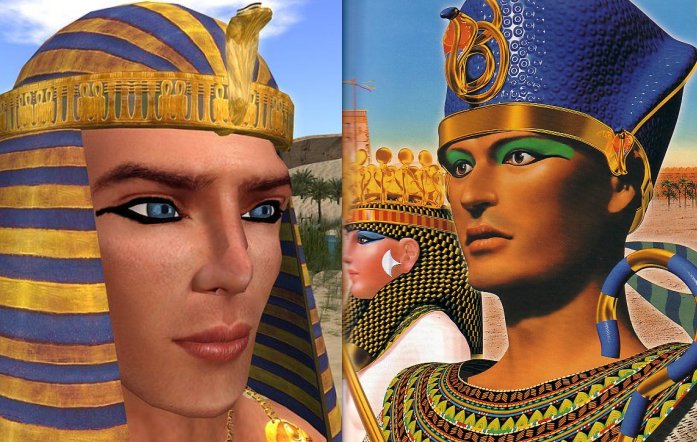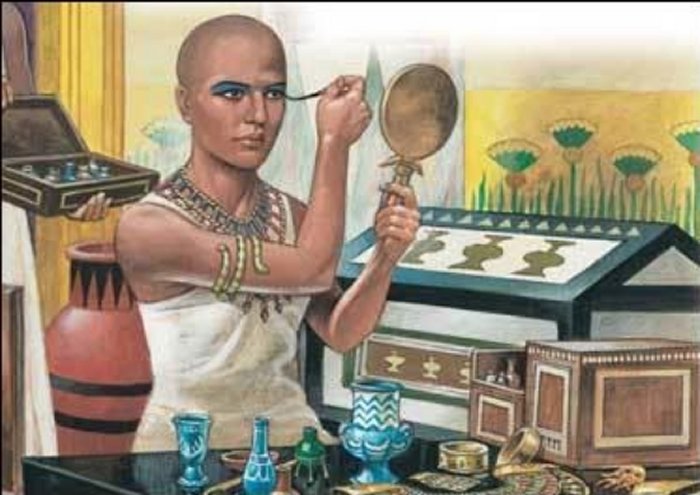Ancient Egyptian Men Used Eye Makeup For Many Reasons
AncientPages.com - Frescoes discovered in ancient Egyptian temples illustrating daily life reveal men often wore makeup. In facts, it’s almost impossible to find a portrait of an ancient Egyptian whose eyes are not decorated.
During all periods and dynasties, eye makeup was a daily prerequisite for both men and women. Why did ancient Egyptian men wear eye makeup? There were a number of reasons actually.
Ancient Egyptian eye makeup was very elaborate and used as early as 4000 B.C. Eye makeup equipment (palettes, grinders, applicators) has been found among the earliest burials of the pre-dynastic period and seem to have been essential items for the afterlife.
Ancient Egyptians used a variety of cosmetics such as eye make up, rouge and perfumed oils that softened the skin and prevented burning in the sun and damage from the sandy winds. Galena powder possesses disinfectant and fly-deterrent properties.
It is believed to offer the eyes protection from intense sun.
The smoky kohl liner served both practical and ritualistic purposes. It was thought to repel flies, protect the eyes from the Sun's rays and ward off infection. Makeup helped to imitate the looks of the gods. Favorite eye make up colors were black and green and outlining the eyes with pigment was deliberately done to created an almond or feline shape.
Eye make up provided psychic protection as well. The Egyptian word for eye-palette seems to derive from their word for "protect." An unadorned and thus unprotected eye was believed vulnerable to the Evil Eye. Outlining the eyes thus became a personal protective amulet drawn right upon the skin; an amulet that once applied could not be lost or misplaced. Makeup was believed to have magical healing powers.
Although cosmetics were certainly used for the purpose of beautification, in ancient Egypt, eye makeup did more than paint a pretty face.
Copyright © AncientPages.com All rights reserved. This material may not be published, broadcast, rewritten or redistributed in whole or part without theexpress written permission of AncientPages.com
More From Ancient Pages
-
 Early Humans Reached Northwest Europe 45,000 Years Ago – New Research Shows
Human Beginnings | Jan 31, 2024
Early Humans Reached Northwest Europe 45,000 Years Ago – New Research Shows
Human Beginnings | Jan 31, 2024 -
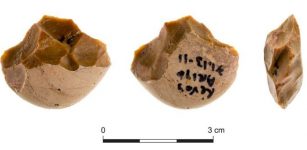 Function Of “Chopping Tools” Found At Prehistoric Site Of Revadim Israel – Studied
Archaeology | Jan 22, 2021
Function Of “Chopping Tools” Found At Prehistoric Site Of Revadim Israel – Studied
Archaeology | Jan 22, 2021 -
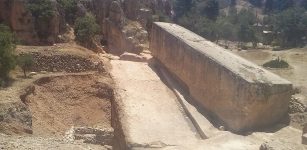 Gigantic Horizontally Lying Stones Of Ancient City Of Baalbek
Civilizations | Mar 10, 2017
Gigantic Horizontally Lying Stones Of Ancient City Of Baalbek
Civilizations | Mar 10, 2017 -
 Unique 1,600-Year-Old Gold Bead Found By Teenager In Jerusalem’s City Of David
Archaeology | Feb 9, 2023
Unique 1,600-Year-Old Gold Bead Found By Teenager In Jerusalem’s City Of David
Archaeology | Feb 9, 2023 -
 Myth Of The Pale Sun Followed By A Catastrophe Confirmed By Archaeologists
Featured Stories | Sep 22, 2024
Myth Of The Pale Sun Followed By A Catastrophe Confirmed By Archaeologists
Featured Stories | Sep 22, 2024 -
 Strange 1,200-Year-Old Anglo-Saxon Artifact Used For Unknown Purpose Found In Norfolk, UK
Archaeology | Jan 18, 2024
Strange 1,200-Year-Old Anglo-Saxon Artifact Used For Unknown Purpose Found In Norfolk, UK
Archaeology | Jan 18, 2024 -
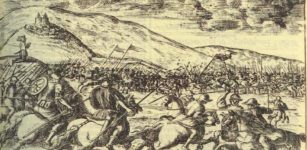 On this day in history: The Battle of the Frigidus – Sep 5, 394 AD
News | Sep 5, 2015
On this day in history: The Battle of the Frigidus – Sep 5, 394 AD
News | Sep 5, 2015 -
 La Garma Cave Offers Evidence Of Over 300,000 Years Of Human Activity
Featured Stories | Dec 5, 2023
La Garma Cave Offers Evidence Of Over 300,000 Years Of Human Activity
Featured Stories | Dec 5, 2023 -
 Has The Mystery Of The Secret Sarcophagus Found At Notre-Dame Cathedral Been Solved?
Archaeology | Sep 25, 2024
Has The Mystery Of The Secret Sarcophagus Found At Notre-Dame Cathedral Been Solved?
Archaeology | Sep 25, 2024 -
 Unknown Neanderthal Lineage Discovered In “Thorin” Who Lived 50,000 Years Ago
DNA | Sep 11, 2024
Unknown Neanderthal Lineage Discovered In “Thorin” Who Lived 50,000 Years Ago
DNA | Sep 11, 2024 -
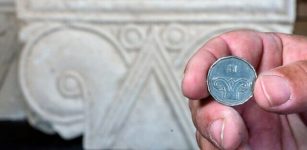 Palace From The Time Of The Kings Of Judah – Unearthed In Jerusalem
Archaeology | Sep 5, 2020
Palace From The Time Of The Kings Of Judah – Unearthed In Jerusalem
Archaeology | Sep 5, 2020 -
 Belenus: Mighty Gaulish God Of Light Often Associated With Lugh And Apollo
Celtic Mythology | Feb 6, 2020
Belenus: Mighty Gaulish God Of Light Often Associated With Lugh And Apollo
Celtic Mythology | Feb 6, 2020 -
 God’s Personal Flying Vehicle Described In ‘The Book of Ezekiel’
Biblical Mysteries | Jul 18, 2019
God’s Personal Flying Vehicle Described In ‘The Book of Ezekiel’
Biblical Mysteries | Jul 18, 2019 -
 On This Day In History: Francis Baily First Observed ‘Baily’s Beads’ – On May 15, 1836
News | May 15, 2016
On This Day In History: Francis Baily First Observed ‘Baily’s Beads’ – On May 15, 1836
News | May 15, 2016 -
 Norse Religion Was Different Than Previously Thought – New Study Reveals
Archaeology | Feb 27, 2021
Norse Religion Was Different Than Previously Thought – New Study Reveals
Archaeology | Feb 27, 2021 -
 Ukko: Karelian-Finnish God Of Thunderstorms, Harvest, Patron Of Crops And Cattle
Featured Stories | Apr 2, 2020
Ukko: Karelian-Finnish God Of Thunderstorms, Harvest, Patron Of Crops And Cattle
Featured Stories | Apr 2, 2020 -
 The Spread Of Weighing Systems Across Western Eurasia 4,000 Years Ago
Archaeology | Jun 30, 2021
The Spread Of Weighing Systems Across Western Eurasia 4,000 Years Ago
Archaeology | Jun 30, 2021 -
 Huginn and Muninn: Powerful Ravens Of Odin, Supreme God In Asgard In Norse Mythology
Featured Stories | Dec 7, 2017
Huginn and Muninn: Powerful Ravens Of Odin, Supreme God In Asgard In Norse Mythology
Featured Stories | Dec 7, 2017 -
 On This Day In History: ‘Sea King’ Ragnar Lodbrok Seizes Paris – On March 28, 845
News | Mar 28, 2017
On This Day In History: ‘Sea King’ Ragnar Lodbrok Seizes Paris – On March 28, 845
News | Mar 28, 2017 -
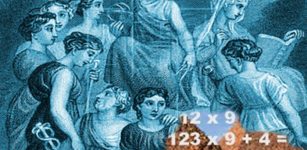 Number Nine: Sacred Symbol In Ancient Cultures
Ancient Symbols | Feb 14, 2017
Number Nine: Sacred Symbol In Ancient Cultures
Ancient Symbols | Feb 14, 2017

